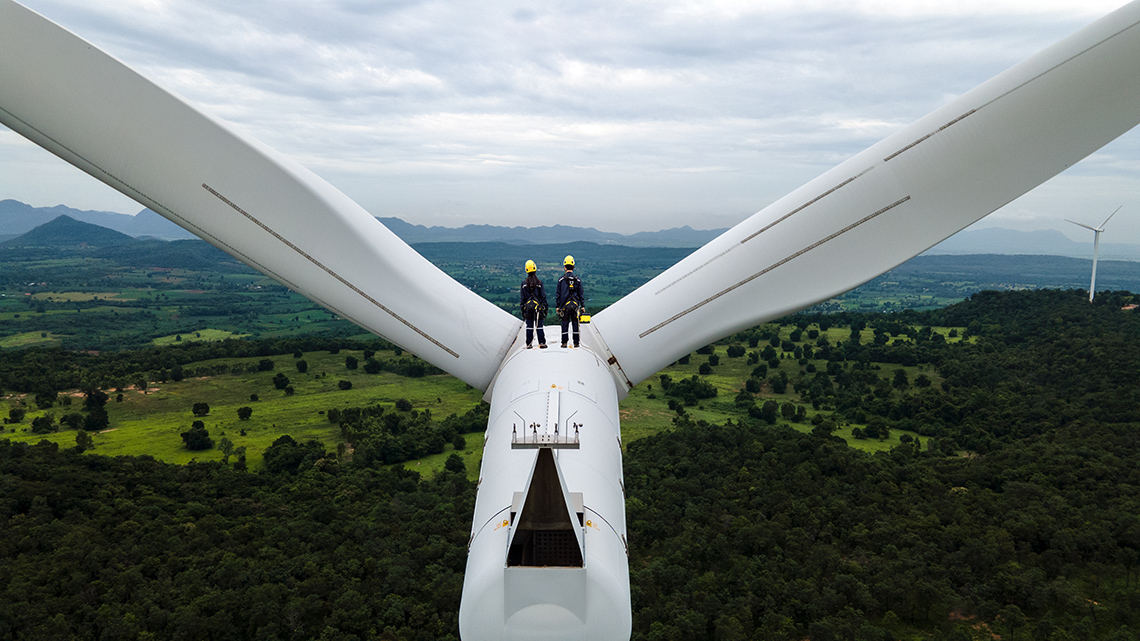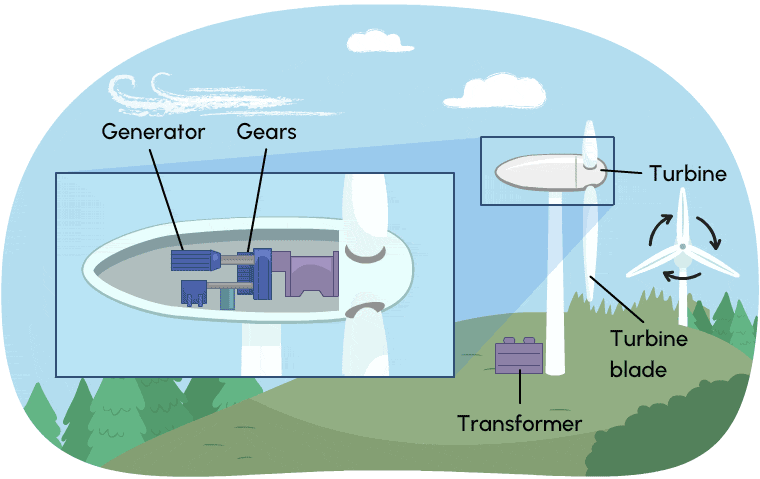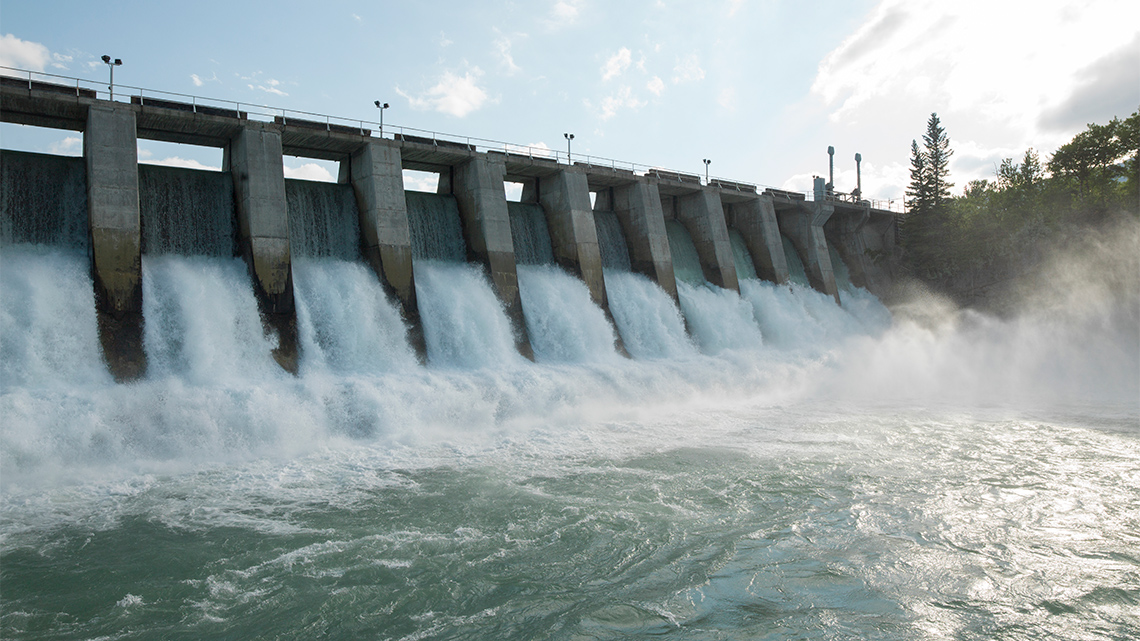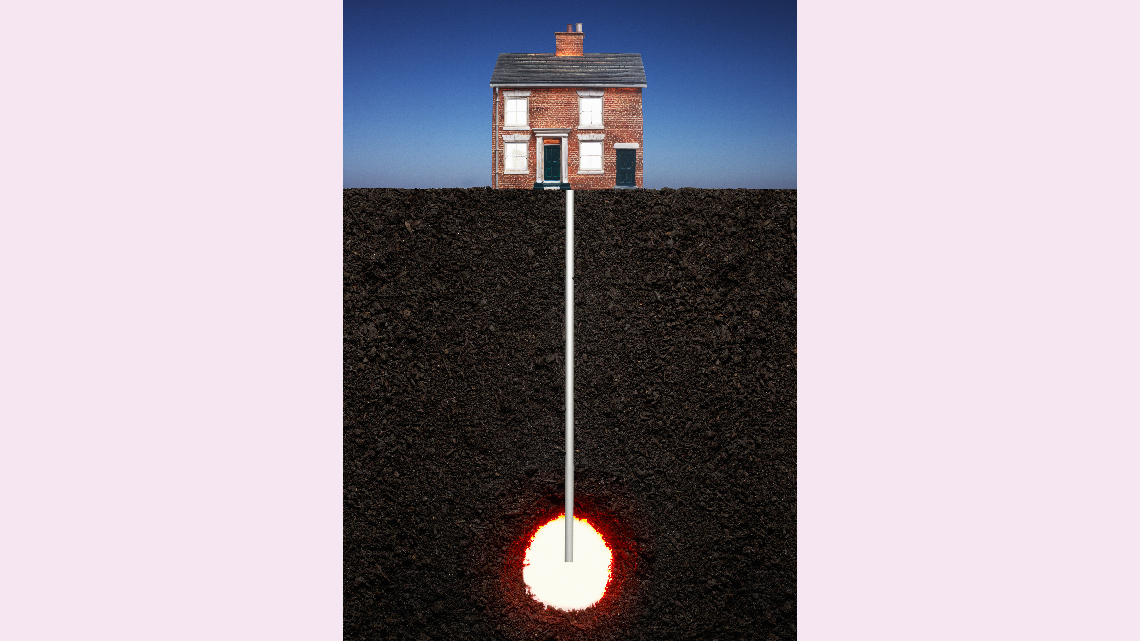Minds On
Renewable energy

What is renewable energy?
Renewable energy is energy that can be replenished by natural processes.
For example, energy from the sun, wind, tides, waves, and biomass.
Investigate
Investigate
Let’s investigate the following images and descriptions of renewable energy sources.
Record what you notice in the following chart provided or using another method of your choice.
Complete the Observe, Infer, and Wonder Activity in your notebook or using the following fillable and printable document. If you would like, you can use speech-to-text or audio recording tools to record your thoughts.

|
I observe… (record points you can observe with senses) |

|
I infer… (record what you think from what you’ve noticed and what you might already know) |

|
I wonder… (record questions you may have) |
Press the ‘Activity’ button to access the Observe, Infer, and Wonder Activity.
Check out the following images, then record your observations:
Action
Renewable energy sources

In the Minds On section, you previously explored wind turbines, hydroelectric dams, and geothermal heat pumps, which are all sources of renewable energy. In this section of the learning activity, you will be learning more about these renewable energy options.
As you are learning about each energy source throughout this learning activity, record some of the advantages and disadvantages.
Complete the Advantages and Disadvantages of Types of Renewable Energy in your notebook or using the following fillable and printable document. If you would like, you can use speech-to-text or audio recording tools to record your thoughts.
| Energy source | Advantages | Disadvantages |
|---|---|---|
| Wind turbines | ||
| Hydroelectric dams | ||
| Geothermal heat pumps |
Press the ‘Activity’ button to access the Advantages and Disadvantages of Types of Renewable Energy.
Wind turbines

Let’s learn more about wind turbines. As you explore, record the advantages and disadvantages you notice about wind turbines as a renewable energy source.
Press the following tabs to access information about wind turbines.
Wind turns the propellor-like blades of a turbine around a rotor, which spins a generator, which creates electricity.
The turbine has three large fan blades at the top of a tall pole. Wind blows and make the turbine blades move. Inside the turbine, there are gears connected to a generator transforming the wind’s energy into electricity. Transformers increase the voltage and then feed the electricity to the power grid.
While we will never run out of wind, it can sometimes be unreliable or intermittent. If wind is too low on some days, the wind turbine won’t generate any electricity. In order to use wind turbines effectively, they need to be paired with some sort of energy storage technology.
Electricity from wind energy is one of the fastest growing methods of electricity generation in the world. The electricity that is generated on wind farms can be used locally or connected to an electric grid to power homes and business further away.
Wind energy is a clean and renewable source of energy and is one of the most cost-effective sources of electricity. Unlike coal, natural gas, or oil, wind energy does not result in greenhouse gas emissions and don’t require any fossil fuels to operate.
While wind turbines are quite expensive to install, once they are up and running, the operating costs are low because the wind is free, and turbines don’t require a lot of maintenance over time.
Wind turbines don’t really take up a lot of space, so the land they are built on can also be used to other things, such as farming. However, they can be noisy and cause visual pollution, and can harm species that fly into them since they turn at such high speeds. When wind turbines are built, sometimes natural habitats or ecosystems are destroyed.
Let’s explore three types of wind turbines: land based, offshore, and distributed wind.

Land based wind turbines range in size and are often more cost effective because they are grouped together to create wind plants and provide bulk power to an electrical grid.

Offshore wind turbines tend to be larger and taller than other wind turbines. These turbines capture powerful ocean winds and generate vast amounts of energy.

When wind turbines are placed on the “customer” side of the electric meter or are installed near a place where the energy will be used, they are called “distributed wind.” Sometimes these are smaller wind turbines used to generate electricity for a home or business.
What were some of the similarities and differences between each type of wind turbine?
Did You Know?
Did you know?
When wind flows across the blade of the wind turbine the air pressure on one side of the blade decreases, which creates lift and drag.
Press the following tabs to access the definitions of lift and drag.
Lift is the upward force on a forward-moving object that results when the air flowing around the top of the object moves faster than the air flowing beneath it.
Drag is the resistance to motion through a fluid, especially the resistive force exerted on an airfoil or airplane by its motion through the air.
For the turbine:
- the force of the lift is stronger, which causes the blade to turn
- the rotor is connected to a generator, which creates electricity

Hydroelectric dams

Let’s learn more about hydroelectric dams. As you explore, record the advantages and disadvantages you notice about hydroelectric dams as a renewable energy source.
Press the following tabs to access information about hydroelectric dams.
A typical hydroelectric plant has three components:
- a powerplant where the electricity is produced
- a dam that is opened or closed to control the flow of water
- a reservoir where the water is stored
The water that is trapped in the reservoir escapes through pipes in the dam. When the water runs through the pipes, it turns a turbine that is linked to a generator that produces electricity.
A hydroelectric dam collects water in the forebay, then channels it via the station’s intake into a pipe called a penstock. The penstock carries water to a spinning turbine, which is connected to a generator transforming the rotation of the turbine into electricity. A transformer increases the voltage of the electricity and sends electricity to the power grid.
Humans have been using the energy of the river currents for centuries. Today, hydroelectric power is used to provide approximately 16% of the world’s electricity.
As with wind turbines, hydroelectric dams are a renewable and clean energy source because they don’t release harmful pollutants into the air or water or require any burning of fossil fuels. While they need water to operate, they do not consume the water they are using. As the water cycle runs naturally, there will always be stored water to operate, which makes them very reliable. Hydroelectric dams can also be very large or small depending on the landscape and energy needs.
One of the issues with hydroelectric dams is that if there is a drought or unpredictable weather trends, it may impact water flow. If the water flow is too low, this decreases the total amount of electricity produced.
Additionally, hydroelectric dams can disturb animal migration paths by interrupting the natural water flow affect water quality, and cause wildlife displacement. Hydroelectric dams are also quite expensive to build and since reservoirs are becoming rarer, this cost is likely only going to increase.
Let’s explore three types of hydroelectric dams: impoundment, diversion, and pumped storage.

An impoundment is the most common type of a hydroelectric power system and is typically larger. Water is released from the reservoir, which turns the turbines that spin and activate the generator to create power.

A ‘run-off river’ facility is where a canal uses the natural decline of the riverbed elevation to produce energy. Water is diverted from the river to a forebay, which then runs downhill through the penstock to a spinning turbine, activating the generator to create power.

Pumped storage works like a giant battery in which a facility stores electricity generated from other sources (wind, solar) by pumping water from a reservoir from lower elevation to high elevation.
Geothermal heat pumps
 Description
Description
A house in summer with a heat exchanger/pump underground, warm water flows down, warmer pipes cool in the ground and cooler water flows up and into the house. Compared to a house in winter with a heat exchanger/pump underground, cool water flow down, warmer ground heats the pipes and warm water flow up and into the house.
Let’s learn more about geothermal heat pumps. As you explore, record the advantages and disadvantages you notice about geothermal heat pumps as a renewable energy source.
Press the following tabs to access information about geothermal heat pumps.
A geothermal heat pump exchanges heat with the earth, rather than the outdoor air. A geothermal heat pump is more than twice as efficient at cooling as any regular heat pump or air conditioner. This is because of the constant temperature of the ground.
The geothermal heat pump pulls heat from the ground, concentrates it, and moves it to your home, rather than producing heat through the burning of fossil fuels.
Buildings that have geothermal heat pumps will save up to 70% in heating costs and 50% in cooling costs, making it a long-term investment. They are an efficient, clean and renewable energy source that reduces the amount of fossil fuels being burned.
While the efficiency is impacted by outside temperatures, ground source heat pumps are not affected by warm or cold climates because the temperature of the earth remains virtually the same regardless of the air temperature above the ground.
One of the issues of geothermal heat pumps is that they are expensive to install. However, there are generally some rebates (money back) people can get from the government for installing one.
Typically, geothermal heat pumps require the entire ground to be dug up on the property, which means it is easier to install a geothermal system during the development of a new building, rather than on an existing building. It is important to be careful with open-loop geothermal systems as it is sometimes possible that they contaminate the water as it cycles ground water.

Closed-loop systems circulate a water-based solution through underground pipes. This water-based solution consists of water and anti-freeze that either deposits or absorbs heat from the ground, depending on the season. The solution enters a heat exchanger in your home that transfers the heat to a heat pump.

Two houses with open-loop geothermal systems. One connects to a hot and cold well. Another has intake and outflow pipes to a body of water.
Open-loop systems are an option if water is plentiful and low in minerals. These systems use groundwater from a well or open body of water as a direct energy source.
After recording your notes, press ‘Let’s Check!’ to access a completed list of advantages and disadvantages for each renewable energy.
Check out the completed Advantages and Disadvantages of Types of Renewable Energy activity chart. You may compare your notes, and record new findings from the following chart.
| Energy source | Advantages | Disadvantages |
|---|---|---|
|
Wind turbines |
|
|
|
Hydroelectric dams |
|
|
|
Geothermal heat pumps |
|
|
Taking action

When designing for sustainable energy use, there are often conflicting and competing priorities.
If a community was building or installing one of the renewable energy sources you explored, who do you think might be involved in the process?
Press ‘Let’s Check!’ to access a possible response.
It is likely the following people would be involved:
- the government
- local residents and business owners
- Indigenous communities
- renewable energy project developers
- environmental and land-use authorities
- and maybe other interest groups
Stakeholders
Stakeholders can have a direct impact on the development or outcome of a project and have valuable input that should be considered. A stakeholder is a person or organization with an interest in or concern about something.
Effective planning of renewable energy sources considers all of these perspectives (both positive and negative) to enhance the likelihood of project success.
Did You Know?
Did you know?
When geographers study issues such as renewable energy, they must consider the issue through a geographic perspective or geographic thinking.
This means they study the world around them with care given to the following three questions:
- What is the social perspective
- What is the environmental perspective?
- What is the economic perspective?
Press ‘Hint’ to access what the questions mean.
- For the social perspective, who are the people involved in the issue and how they are impacted.
- With the environmental perspective, how is the environment impacted by this issue.
- The economic perspective considers the actual cost associated with this issue and how that impacts the issue.
So, how does this compare to what scientists have to consider when designing for sustainable energy use? Can geography and science be related in some ways?
Record your ideas in a notebook or another method of your choice.
Press ‘Let’s Check!’ to access a possible response.
Geography can be studied as a physical science. Geographers collect and study data and draw conclusions based on their observations.
Perspectives
For this investigative activity, let’s explore the following steps:
1. Choose one of the renewable energy sources that we previously explored:
- wind turbine farm
- hydroelectric dam
- geothermal heat pumps
2. Choose one perspective from a stakeholder to conduct your investigation.
Consider the following:
- Of the perspectives we brainstormed, who might benefit from this project and who may be negatively impacted?
- How would you go about gather input from these stakeholders?
Press ‘Hint’ to access additional details.
You could connect with them virtually or in person to gather and share relevant information about the project, consult on key questions, provide feedback on potential obstacles, offer insight into the project, or discuss findings.
3. Explore this video to learn about the steps of the Scientific Research Process.
For this activity, you will focus on the skills related to asking, researching, recording, and analyzing.
4. Complete From a Stakeholder’s Perspective in your notebook or using the following fillable and printable document. If you would like, you can use speech-to-text or audio recording tools to record your thoughts.
Choose one perspective and conduct research to help you complete the following graphic organizer.
|
Renewable energy choice: Wind turbines, hydroelectric dams, or geothermal heat pumps? |
|
|
Stakeholder perspective: Government, environmental group, local resident, business owners, renewable energy project developer, etc. |
|
|
What might be of concern to this stakeholder? What questions might they have? |
|
|
How might this project benefit the stakeholder? |
|
|
What else might they think, do, or say about the issue? |
Press the ‘Activity’ button to access the From a Stakeholder’s Perspective.
Consolidation
Future impacts
This learning activity connects new and existing approaches for young scientists to create positive changes in their communities.

Review your learning
Try It
Your turn!
A community is trying to decide if they should install wind turbines, a hydroelectric dam, or geothermal heat pumps as a new renewable energy project.
Your task is to give them information about each energy source, including the advantages, disadvantages, and community impacts of the energy source to help them make a decision.
You could create an oral presentation, virtual slideshow, or video that addresses the community members. Alternatively, share your ideas using another method of your choice.
You may use the following checklist to guide your thinking.
Reflection
As you read the following descriptions, select the one that best describes your current understanding of the learning in this activity. Press the corresponding button once you have made your choice.
I feel…
Now, expand on your ideas by recording your thoughts using a voice recorder, speech-to-text, or writing tool.
When you review your notes on this learning activity later, reflect on whether you would select a different description based on your further review of the material in this learning activity.


